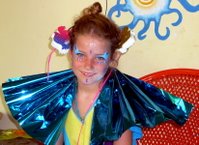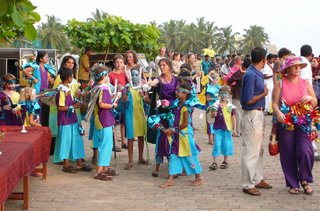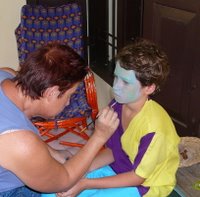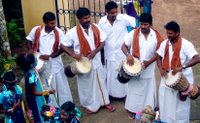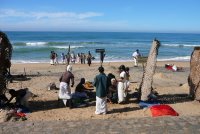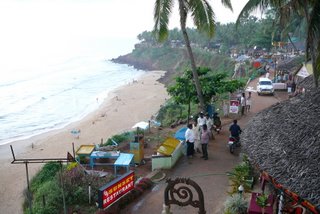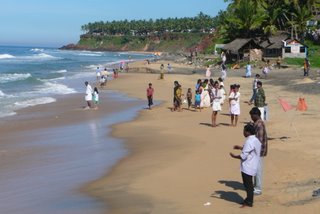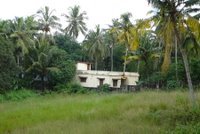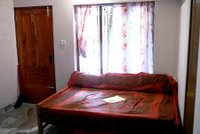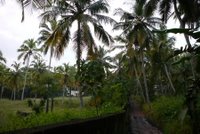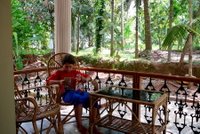Many of you have asked questions about our daily life in Varkala. I will attempt to paint you a picture of a typical day spent at home.
We wake to the sounds of dogs barking, birds singing or crowing, the local carpenters already at work, pots and pans being washed, large bangs from the local temple (it sounds like a shotgun) and Indian music blaring from one house were they love the equivalent of MTV. It is already warm and sunny out as we roll out of bed around 7:15 am.
Everyone helps assemble breakfast. We start with fresh peeled oranges, which are more like tangerines, then prepare muesli, Kerala style. Rob likes to roast the raw cashew nuts and then the oat flakes. Kathleen loves to cut up the dried coconut (most of it ends up in her mouth and not in the dishes). We chop dates, slice bananas, cut pineapple, add a few Corn Flakes and smother with rich curd (yogurt), to make a delicious and hearty breakfast. Steve makes the coffee. (A heartfelt thank-you to Steve’s parents for giving us the 1-cup Bodum coffee maker.)
The path to the beach

After breakfast we head out for a swim. In the morning we like to go to Black Beach, where the water is calmer and there are fewer people. It is a leisurely 20-minute walk and a good way to get some exercise in the cooler part of the day.

We arrive back home around 10:30 am and tackle some household chores before getting into a bit of homework before lunch. All housework is done by hand: Steve does most of the laundry in a bucket; the floors constantly need sweeping because we walk inside in bare feet we feel the dirt on the floors! We sweep with a short broom made of palm fronds.

Lunch at home can be leftover Indian supper, scrambled eggs with tomatoes, cheese and toast or toasted tomato, cucumber and cheese sandwiches or macaroni with either cheese or tomato sauce. Obviously we were glad to finally find a place to buy cheese. A favorite is Grammy Maher’s French fries. The kids can’t believe we never have them at home!

In the afternoon, it is back to the books, math exercises on the computer, reading, writing letters, blogs, postcards and stories. As well, we are doing plenty of things we seem to never have time for at home -chess, checkers, scrabble in French (the kids are getting quite good) and English, painting, reading, crosswords, sudoku and charades. We are teaching ourselves to play recorders and harmonicas. Rob has learned some recorder in school, so he is lead teacher. Right now we are working on our Christmas tunes. Rob has learned how to play Silent Night and Good King Wenceslas and is teaching these to Steve as part of our family home Christmas pageant for Great Aunt Jane. Kathleen and Ann are working on the harmonica parts of these songs.

At about 3:00 pm it’s teatime; we munch on cookies and pineapple with a spot of tea. We’ve been known to have a nap in the afternoon. There are visits with the neighbours or some surfing on the net if the power is on or reading the paper. We subscribe to The Hindu, a well-written newspaper that provides insight into the complex world of Indian politics and a refreshing point of view on international stories.

Then at about 3:45 p.m. three small boys with beautiful smiles appear in front of the kitchen window. They are standing on the 8-foot high, stone wall about 10 feet from the window. They call “Robert” in a way that sounds like “Rabbit” which immediately puts a smile on my face. “Robert” means: Is Robert there, can he come out and play football (soccer) with us, is Kathleen there and can she come too? Sometimes Steve and Rob are just finishing up a project and they say ten minutes more. The boys wait patiently on the wall for Rob to cry, “I’m done!” And then the war hoop goes out “Rabbit, Rabbit, Rabbit” as the news is relayed to the rest of the players in the soccer field just on the other side of the wall. Rob grabs his ball and he and Kathleen rush out to play, grinning ear to ear and in bare feet like all the other kids. They play in the paddy next door under a canopy of coconut branches. The ball ricocheting off the trees are just extra men on the field. The neighbourhood kids are wonderful, very polite and generous. They provide us with our coconut for our breakfasts (and have shown Rob and Kate how to spot a good one and open it using a rock and the stone wall). Besides the fresh coconut, our local kids have taught ours to weave rope and jewelry out of the banana leaves, run on this 8-foot high wall (I am not so sure about that) and improve their confidence on the soccer field. We are the chief suppliers of cold water, which our kids have learned to drink Keralan style (say’s Kathleen very proudly, which means drinking without touching the lip of the bottle) and Band-Aids. Our kids on the field have attracted more than a few onlookers, as they are the only white kids, and Kathleen the only girl on the field. Other tourists have seen them and have come to take pictures of the kids playing. They seem to be quite taken by how much fun the kids are having even if they don’t speak the same language. An Israeli film producer here on holidays has taken over 500 shots of the kids playing soccer, which he plans to make into a montage type movie. (He gave us a CD of the photos). He and his wife came for tea one day and we talked about making movies, living in a working Kibbutz, and how they try to ignore the constant fear of attack.

Sometimes we see the kids all sitting in the shade and so I asked Kathleen what they talk about. She said “everything and anything”; obviously, language is not an issue. Kathleen is our little emissary for information on what’s happening in the neighbourhood. Rob may be the center of attention on the soccer field with his new ball, but Kathleen is known just about everywhere else. She has her route to visit all the neighbours: Jasmine and her sister, Jismane with her 6 month baby boy Mahu, her new friend Kitty, Patma with her dog “Johnny”, etc. Anywhere we go we hear “Kathleen, Kathleen” from the shopkeepers and restaurant owners, the boys renting the parasols at the beach, and lots of other tourists on the beach or on the cliff. If we want to know what’s goin’ on, chances on Kathleen has heard it first!

After soccer we usually make a trip to the beach, which may include bringing along drinks and snacks for refreshments while we watch the sun set into the Arabian Sea. We have to remember to bring a flashlight because it will be dark by 6:30pm for the walk home. Time for a quick shower and then we eat supper. A couple of nights a week we have Kumari deliver Indian food, other nights Ann cooks pasta with veg, or we go out to a restaurant.
After supper, we might check the emails (keep ‘em coming, we love to hear from you), do the dishes and then have a game or two. The hottest game at the moment is “Euchre”. Steven taught the kids about a week ago and since then we have had to play every night! The kids learned so quickly that Steve and I are regularly getting euchred now. As well as teaching Kate and Rob this Ontario game, Steve is acquainting the kids with some of the Haliburton lore, including such gems as “John Ham never turned down a right bower”, Aunt Ellen would play it alone if at all possible and Unk hated to follow suit. Next on the program is the maritime game, 45’s.
The day ends with getting down the mosquito nets and reading a chapter to the kids (current book is Cheaper by the Dozen). Steve and I stay up a bit longer, reading our books and sending emails. By 11pm we are in bed and sleep until the dogs start barking!
 Ça faisait deux semaines depuis que ma sœur et moi avons envoyé nos lettres par courriel au Père Noël pour lui donner nos listes de cadeaux. La Veille de Noël nos bas étaient accrochés sur une chaise pour attendre le Père Noël. Le lendemain nous avons eu hâte de voir nos bas remplis, et il y avait beaucoup, beaucoup de cadeaux que le Père Noël avait apportés.
Ça faisait deux semaines depuis que ma sœur et moi avons envoyé nos lettres par courriel au Père Noël pour lui donner nos listes de cadeaux. La Veille de Noël nos bas étaient accrochés sur une chaise pour attendre le Père Noël. Le lendemain nous avons eu hâte de voir nos bas remplis, et il y avait beaucoup, beaucoup de cadeaux que le Père Noël avait apportés. La journée avant Noël, papa et moi avons coupé une branche de palmier, pour prendre la place du sapin de Noël. Nous avons rempli un sceau avec du sable pour tenir la branche debout. Nous l’avons placé dans le salon pour nous faire penser à Noël. Cette journée nous avons fait des décorations pour l’arbre que nous avons accroché avec les lumières. La soirée venue, au bas de l’arbre il y avait beaucoup de cadeaux pour notre famille. La journée de Noël, après que tous les cadeaux sont ouverts, papa a monté l’arbre pour qu’on le voie pendant notre souper de Noël sur le toit.
La journée avant Noël, papa et moi avons coupé une branche de palmier, pour prendre la place du sapin de Noël. Nous avons rempli un sceau avec du sable pour tenir la branche debout. Nous l’avons placé dans le salon pour nous faire penser à Noël. Cette journée nous avons fait des décorations pour l’arbre que nous avons accroché avec les lumières. La soirée venue, au bas de l’arbre il y avait beaucoup de cadeaux pour notre famille. La journée de Noël, après que tous les cadeaux sont ouverts, papa a monté l’arbre pour qu’on le voie pendant notre souper de Noël sur le toit. C’était mon premier Noël avec une température de 30ºC, comme ça nous pouvons manger à la plein aire. Notre toit est tout plat et serve comme une terrasse où nous avons apportés une table à manger. Le souper de Noël était préparé par notre voisine qui a cuit un poulet au cari délicieux. Pour terminer la soirée notre famille a présenté des chants de Noël et joué les rôles des personnages.
C’était mon premier Noël avec une température de 30ºC, comme ça nous pouvons manger à la plein aire. Notre toit est tout plat et serve comme une terrasse où nous avons apportés une table à manger. Le souper de Noël était préparé par notre voisine qui a cuit un poulet au cari délicieux. Pour terminer la soirée notre famille a présenté des chants de Noël et joué les rôles des personnages.

































